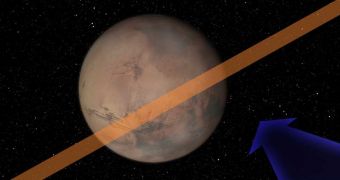No wonder NASA received funding cuts for its Near Earth Object program, as it seems they are spending a lot of money on nothing. The threat at which NASA is exposing the human race to got updated in late November last year when asteroid 2007 WD5 was discovered. Upon calculating the trajectory of the object through the inner regions of the solar system, astrophysicists gave it a chance of 1 in 350 that the asteroid would hit planet Mars on January 30 this year.
Further observations of its orbit greatly increased the chance to more than 1 in 75, and, on January 2nd, astronomers revealed that the asteroid has a probability of hitting the Red Planet of 3.9 percent, meaning 1 in 28 odds.
Discovered on 30 November, the asteroid 2007 WD5 has a diameter of about 50 meter, and, incredibly, it was detected five days after it passed near the Earth!!! The object is comparable in size with the asteroid that exploded over the Siberian regions of Tunguska in 1908, which released an amount of energy equivalent to about 20 megatonnes of TNT, leveling 200 square kilometers of forest.
If it were to hit the Red Planet, 2007 WD5 would create a crater the size of world famous Meteor Crater in Arizona, United States, which was generated more than 50,000 years ago. Due to the unique character of such a phenomenon, NASA deployed its whole arsenal of space probes to capture the potential catastrophic event. Unlike the Earth, which has a dense atmosphere that would detonate the impactor well before it hits the ground, Mars with its thin atmosphere would permit the asteroid to reach the surface of the planet relatively intact.
Calculations regarding a potential hit suggest that the object would probably fall somewhere in the equatorial regions of the planet, close to the location of NASA's Opportunity Martian rover, but the asteroid traveling at more than 49,000 kilometers per hour towards Mars would leave the vehicle untouched by the blast of the explosion.
Collision expert Mark Boslough presents two possible scenarios that might unfold during the asteroid's entry into the Martian atmosphere: either it would hit the surface in one piece or it might break up in multiple fragments to create a number of smaller craters. The model of the break up became well known during the event which involved comet Shoemaker-Levy 9, that disintegrated in multiple fragments due to Jupiter's powerful gravitational field as it passed through its vicinity, and impacted the planet over a period of six days, creating fireballs larger than the diameter of the Earth.
Chance make that, similarly to the Galileo spacecraft which recorded the whole event back in 1994, the Mars Reconnaissance Orbiter is just where it should be, in Mars' orbit, to capture the cataclysmic event. The MRO probe will closely follow the asteroid in its path, and will probe it for any signs of organic materials such as those essential for life.

 14 DAY TRIAL //
14 DAY TRIAL //